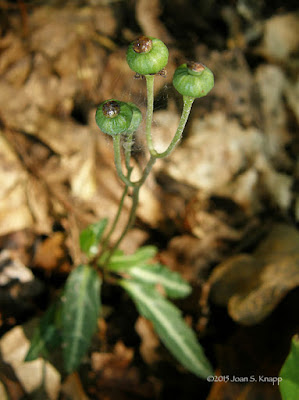The early spring wildflowers have finished blooming; it’s time to
watch the developing fruit. Summer wildflowers were still blooming but it was
time to turn attention to the fungi in the woods.
In the woods, just before I crossed the ‘first’ bridge, I
checked on the…
Solomon’s Seal (Polygonatum biflorum) fruit that were black
now; probably ripe.
The seed capsules were still developing on the Pipsissewa (Chimaphila maculata) just past the
bridge.
Further along the trail, the seed capsule on the Eastern
Sweetshrub (Calycanthus floridus) was
completely ripe. These capsules may remain attached to the plant into the
winter. I’ll be checking to see how long this capsule hangs on.
The seeds in the Wild Yam (Dioscorea villosa) were visible though the seed capsule but they
weren’t ripe. They hadn’t changed in the previous week.
The seed capsules and
flower buds on the witchhazel (Hamamelis
sp.) hadn’t changed either;
neither had the seed capsules on the Mountain Azalea (Rhododendron canescens).
The second Eastern Sweetshrub fruit. It would now be a
waiting game to see how long the fruit remained on the bush.
Just south of the Fishing Area bridge, I found this bolete
with an exquisitely reticulated stem. I believe that it’s Atkinson’s Bolete (Boletus atkinsonii), a member of the
Boletus edulis (King’s Bolete) group. This species has a dry, leathery cap compared
with the sticky cap of B. edulis.
The fruit
on the Buttonbush (Cephalanthus
occidentalis) were unchanged from the previous week. I wondered how long it
would take for these to mature.
At the south end of the main Fishing Area, I found a Spicebush
Swallowtail (Papilio troilus)
enjoying the sun.
At the north end of the Fishing Area, more clusters of the the mushrooms,
tentatively identified as a Hypholoma
sp. (possibly H. fasciculare), I had
seen the previous week had grown. were in various stages of development.
Groundnut (Apios americana)
was still blooming at the water’s edge.
In the woods along the Rock Garden trail, I found some…
Hairy Elephantfoot (Elephantopus
tomentosus) still blooming.
The Resurrection Fern (Pleopeltis
polypodioides) were hydrated.
Most of the seed capsules on the Wild Yam (Dioscorea villosa) vine just below the Resurrection Fern had almost
completely matured.
The shade in these woods was a welcome relief from the summer’s
heat.
The fruit on the Eastern Sweetshrub in these woods had matured
too.
The Broadleaf Ironweed (Vernonia
glauca) plant was still blooming nearby.
I was surprised to find a Small Wood Sunflower (Helianthus microcephalus) in these
woods.
I was also surprised to find a Smooth Yellow False Foxglove (Aureolaria flava) blooming. I thought
these had finished for the year.
My final sighting on the Rock Garden trail was this beautiful
Frost’s Bolete (Exsudoporus frostii).
Then, back to the main trail towards the Old Fort.
(To be continued…)
References:
- Mushroom
Expert. Kuo, M. (2010 March): Boletus atkinsonii
- Mushroom
Expert. Kuo, M.(2013 December): Exsudoporus frostii (Boletus frostii)
- Go Botany: Helianthus microcephalus
- Go Botany: Helianthus microcephalus
Related posts:




























No comments:
Post a Comment